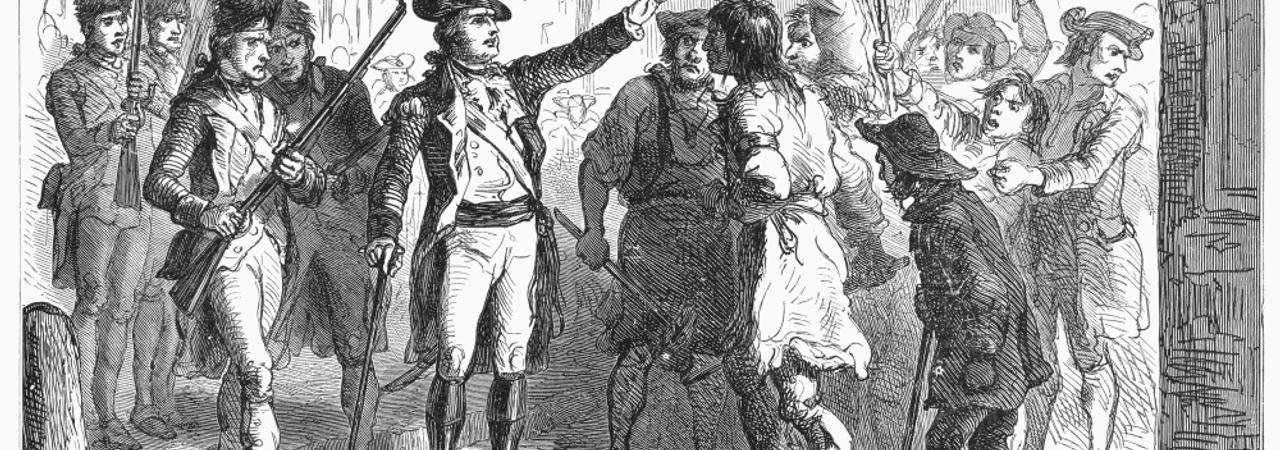
The North Carolina Regulator War was a series of backcountry settlers' insurrections against the corrupt provincial local government. Here are 10 facts to help you learn more about the little known War of the Regulators.
Fact #1: The perpetrators of the abuses towards the colonists were known as the "courthouse ring"
The targets of the colonists' anger were the appointed officials of the local government who financially abused them. The colonists referred to the group of corrupt officials as the "courthouse ring" because they would use the court to extort and mistreat the people. Part of the issue stemmed from the fact that the officials were appointed by higher authorities, rather than elected by the public. When farmers or other colonists were unable to pay their debts or taxes, they were brought to court where these judges and lawyers or even sheriffs would overtax them or take their goods through the action of the court, disguising their illicit activities as legal. The fact that the very people who were appointed to maintain justice had become the perpetrators of blatant injustices was a main cause of the Regulator rebellion.
Fact #2: George Sims, author of the "Nutbush Address," was arrested for libel
The "Nutbush Address" was a speech that was turned into a circulating document that moved colonists to recover their rights and speak out against governmental corruption and tyranny. George Sims, the author of the Address, was a schoolteacher experiencing the injustices just as the farmers were. Within the Address, Sims called out one official in his county, Samuel Benton, the Clerk of the Court, for perverting the justice of the government. Although Sims maintained loyalty to the government, his actions were enough to anger Samuel Benton. Benton accused Sims of libel, sued him, and had him arrested. Sims' words were not in vain though, as "The Nutbush Address" provided a starting point for the Regulators who resonated deeply with the speech.
Fact #3: The Regulators stormed an in-session court to protest the courthouse rings and corruption
In September 1770, about 150 Regulators marched into the eastern town of Hillsborough and stormed the court. They interrupted the court session armed with clubs, and disrupted the proceedings, attacking multiple officials including the despised Edmund Fanning, who the Regulators saw as the embodiment of corruption. After looting the courthouse and destroying Fanning's own home, the mob set up their own mock trial in the court. They also inputted their own profane entries into the court docket. It was because of this riot that the general assembly soon after enacted the Johnston Riot Act, a means by which they could punish all those who incited or participated in riots from then on.

Fact #4: The War only had 1 real battle
While the Regulators protested and fomented insurrection against their local government for multiple years, they only clashed in 1 real battle throughout the entire war: The Battle of Alamance. On May 16, 1771, about 2,000 untrained Regulators fought the colonial militia, led by Governor William Tryon. The battle was finished within two hours, and with a militia victory, the battle, and the Regulator War in its entirety ended.

Fact #5: Nobody knows the number of Regulator casualties from the Battle of Alamance
The Battle of Alamance was a quick battle, only lasting about two hours from start to finish. While the casualties on the side of the colonial militia was documented, the Regulator casualties were not. Throughout the battle, the Regulators hid behind trees and rocks, and when one of their own was killed or injured, they would immediately remove them from the battlefield. Once removed, they failed to record the deaths and injuries, and therefore, nobody knows the Regulator numbers that were suffered that day. One source estimates that about 20 may have been killed and possibly 100 wounded, but these numbers do not appear in other sources. On the side of the colonial militia, 9 men were killed and 61 were wounded.
Fact #6: The Regulator force was nearly double the colonial militia when they clashed
At the Battle of Alamance, Governor Tryon had recruited about 1,000 militia to take on the Regulators. Even without knowing the numbers of the Regulators, Governor Tryon was confident that his men would defeat their opponents because he knew the strength of his militia. On the day of the Battle, nearly 2,000 Regulators fought against the milita; however, despite having nearly double the number of men, the Regulators were quickly defeated. They had insufficient supplies, limited weapons, and were lacking a strong system of leadership which, coupled with the military training and preparedness of the militia, resulted in a swift defeat.
Fact #7: After the Battle of Alamance, governmental corruption continued
The Regulators protested for years throughout the war, trying to reform the corrupt local government that was in place. They made some headway, successfully getting two men of their own appointed to the general assembly - Herman Husband and John Pryor. Although, one of the appointed Regulators, Herman Husband, was eventually expelled from the assembly after being accused of inciting riots. However, even after their best efforts, the Regulators' loss at the Battle of Alamance ensured that the system remained corrupt. Sources even say that, after the battle, Governor Tryon raised taxes once more to pay for the militia that fought at Alamance. However, the Regulator Movement had made a mark on the colony and had allowed like-minded colonists to fight for a cause that they believed in.
Fact #8: Most Regulators swore loyalty to the government after the war
After the Battle of Alamance, seven Regulators were executed. However, in terms of the other Regulators, most of them were discovered and forced to sign loyalty oaths to the royal government in exchange for pardons for their rebellious actions. Over 6,000 Regulators and sympathizers signed the pledges seeking amnesty. Those who would not sign loyalty oaths either went into hiding or exile. Some joined other rebel groups and continued to fight against governmental corruption.
Fact #9: Some sources claim that the Regulator War was a catalyst to the American Revolution
It is a highly disputed claim that the Regulator War laid the foundation for the American Revolution. Some sources even claim that the Battle of Alamance was the first battle of the American Revolution (as seen in the postcard image above). However, while there are similarities between the Regulator War and the American Revolution, such as the anger about unjust taxation, the two wars were fought for fundamentally different reasons. The Regulator War was a local civil war that was waged against corrupt government officials in response to injustices and mistreatment. The goal of the war was to regulate the government and abolish the corruption that festered within it. There were no talks of overthrowing the government as there would be a few years later in the American Revolution.
Fact #10: The American Revolution divided the Regulators
Another reason that the Regulator War can be differentiated from the American Revolution is that the goals of the Revolutionary War divided the Regulators between sides. Some Regulators stayed loyal to the British, because the Regulator movement had never been an effort to separate from the royal government, and they still believed in the sovereignty of England. Other Regulators joined the Patriot movement. Therefore, during the American Revolution, Regulators who had been fighting alongside each other four years earlier were now taking up arms against each other. Furthermore, many members of Governor Tryon's militia also joined the Patriot cause, meaning they also fought alongside the Regulators that they had previously defeated.


